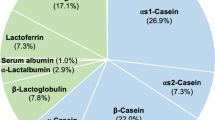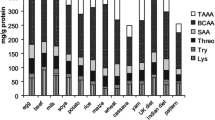Abstract
The profile of fatty acids (FA) in the milk fat of two Iranian fat-tailed sheep breeds, Sanjabi and Mehraban, was compared during lactation. Eight ewes of each breed, balanced in parity and carrying one foetus, were selected before parturition. Ewes were kept separated in individual pens during the experimental period, under the same management practices and fed the same diet, in order to eliminate any confounding effects on milk FA profile. Milk was sampled at biweekly intervals up to 10 weeks of lactation, starting 2 weeks after parturition. More than 100 FA were determined in milk fat by means of gas chromatography. The milk fat of Sanjabi ewes contained more cis-9 18:1, that of Mehraban ewes was richer in 10:0, 12:0 and 14:0, and no differences were found for 16:0 and 18:0. No breed differences were found for most branched-chain FA. Mehraban ewes showed a higher presence of vaccenic and rumenic acids in their milk fat. The milk fat of Sanjabi ewes had a lower atherogenicity index and n-6/n-3 FA ratio. The contents of several FA showed time-dependent changes, so breed differences were more apparent or disappeared as lactation progressed. The milk fat of Sanjabi ewes showed a better FA profile from the human health point of view.
Similar content being viewed by others
References
Alves, S.P., Bessa, R.J.B., Quaresma, M.A.G., Kilminster, T., Scanlon, T., Oldham, C., Milton, J., Greeff, J., Almeida, A.M., 2013. Does the fat tailed Damara ovine breed have a distinct lipid metabolism leading to a high concentration of branched chain fatty acids in tissues? PLOS ONE, 8, e77313.
Bichi, E., Toral, P.G., Hervás, G., Frutos, P., Gómez-Cortés, P., Juárez, M., De la Fuente, M.A., 2012. Inhibition of ∆9-desaturase activity with sterculic acid: effect on the endogenous synthesis of cis-9 18:1 and cis-9 trans-11 18:2 in dairy sheep. Journal of Dairy Science, 95, 5242–5252.
Bodas, R., Manso, T., Mantecón, A.R., Juárez M., De la Fuente, M.A., Gómez-Cortés, P. 2010. Comparison of the fatty acid profile in cheeses from ewes fed diets supplemented with different plant oils. Journal of Agricultural and Food Chemistry, 58, 10493–10502.
De la Fuente. L.F., Barbosa. E., Carriedo. J.A., Gonzalo. C., Arenas. R., Fresno. J.M., San Primitivo, F.S., 2009. Factors influencing variation of fatty acid content in ovine milk. Journal of Dairy Science, 92, 3791–3799.
Degen, A.A., 2007. Sheep and goat milk in pastoral societies. Small Ruminant Research, 68, 7–19.
FAOSTAT, 2015. Food and Agriculture Organization of the United Nations (FAO), Rome. http://faostat3.fao.org/browse/Q/QA/E. Accessed 25 Jan 2016.
ISO-IDF, 2002. Milk fat–Preparation of fatty acid methyl esters. International Standard ISO 15884-IDF 182: 2002. Brussels, Belgium: International Dairy Federation.
Izadifard, J., Zamiri, M.J., 1997. Lactation performance of two Iranian fat-tailed sheep breeds. Small Ruminant Research, 24, 69–76.
Loften, J.R., Linn, J.G., Drackley, J.K., Jenkins, T.C., Soderholm, C.G., Kertz, A.F., 2014. Palmitic and stearic acid metabolism in lactating dairy cows. Journal of Dairy Science, 97, 4661–4674.
Luna, P., Juárez, M., De la Fuente, M.A., 2005. Validation of a rapid milk fat separation method to determine the fatty acid profile by Gas Chromatography. Journal of Dairy Science, 88, 3377–3381.
Martínez Marín, A.L., Gómez-Cortés, P., Gómez Castro, G., Juárez, M., Pérez Alba, L., Pérez Hernández, M., De la Fuente, M.A., 2012. Effects of feeding increasing dietary levels of high oleic regular sunflower or linseed oil on fatty acid profile of goat milk. Journal of Dairy Science, 95, 1942–1955.
Mierlita, D., Daraban, S., Lup, F., 2011a. Effects of breed on milk fatty acid profile in dairy ewes, with particular reference to cis-9, trans-11 conjugated linoleic acid. South African Journal of Animal Science, 41, 223–231.
Mierlita, D., Padeanu, I., Maerescu, C., Chereji, I., Halma, E., Lup, F., 2011b. Comparative study regarding the fatty acids profile in sheep milk related to the breed and parity. Analele Universitatii din Oradea, 10, 221–232.
Mozaffarian, D., de Oliveira Otto, M.C., Lemaitre, R.N., Fretts, A.M., Hotamisligil, G., Tsai, M.Y., Siscovick, D.S., Nettleton, J.A., 2013. Trans-palmitoleic acid, other dairy fat biomarkers, and incident diabetes: the Multi-Ethnic Study of Atherosclerosis (MESA). American Journal of Clinical Nutrition, 97, 854–861.
National Research Council, 1985. Nutrient Requirements of Sheep 6th rev ed, (National Academy Press, Washington DC).
Nudda, A., Battacone, G., Boaventura Neto, O., Cannas, A., Francesconi, A.H.D., Atzori, A.S., Pulina, G., 2014. Feeding strategies to design the fatty acid profile of sheep milk and cheese. Revista Brasileira de Zootecnia, 43, 445–456.
Palmquist, D.L., Beaulieu, A.D., Barbano, D.M., 1993. Feed and animal factors influencing milk fat composition. Journal of Dairy Science, 76, 1753–1771.
Rozbicka-Wieczorek, A., Radzik-Rant, A., Rant, W., Czauderna, M., 2013. The content of conjugated linoleic acid (CLA) isomer groups in milk of two Polish sheep breeds determined by silver ion liquid chromatography (Ag+-HPLC). Folia Biologica, 61, 107–111.
Rozbicka-Wieczorek, A.J., Radzik-Rant, A., Rant, W., Kuczynska, B., Czauderna, M., 2015. Characterization of the milk lipid fraction in non-dairy sheep breeds. Archives Animal Breeding, 58, 395–401.
Sauvant, D., Perez, J.M., Tran, G., 2004. Tables of Composition and Nutritional Value of Feed Materials: Pigs, poultry, cattle, sheep, goats, rabbits, horses and fish, (Wageningen Academic Publishers, Wageningen, The Netherlands).
Shingfield, K.J., Chilliard, Y., Toivonen, V., Kairenius, P., Givens, D.I., 2008. Trans fatty acids and bioactive lipids in ruminant milk. Advances in Experimental Medicine & Biology, 606, 3–65.
Shingfield, K.J. and Wallace, R.J., 2014. Synthesis of conjugated linoleic acid in ruminants and humans. In: B. Sels and A. Philippaerts (eds), Conjugated linoleic acids and conjugated vegetable oils, (Royal Society of Chemistry, London, UK), 1–64.
Signorelli, F., Contarini, G., Annicchiarico, G., Napolitano, F., Orrù, L., Catillo, G., Haenlein, G.F.W., Moioli, B., 2008. Breed differences in sheep milk fatty acid profiles: Opportunities for sustainable use of animal genetic resources. Small Ruminant Research, 78, 24–31.
Simopoulos, A.P., 2008. The importance of the omega-6/omega-3 fatty acid ratio in cardiovascular disease and other chronic diseases. Experimental Biology and Medicine, 233, 674–688.
Sinanoglou, V.J., Koutsouli, P., Fotakis, C., Sotiropoulou, G., Cavouras, D., Bizelis, I., 2015. Assessment of lactation stage and breed effect on sheep milk fatty acid profile and lipid quality indices. Dairy Science & Technology, 95, 509–531.
Talpur, F.N., Bhanger, M.I., Memon, N.N., 2009. Milk fatty acid composition of indigenous goat and ewe breeds from Sindh, Pakistan. Journal of Food Composition and Analysis, 22, 59–64.
Tsiplakou, E., Kominakis, A., Zervas, G., 2008. The interaction between breed and diet on CLA and fatty acids content of milk fat of four sheep breeds kept indoors or at grass. Small Ruminant Research, 74, 179–187.
Tsiplakou, E., Mountzouris, K.C., Zervas, G., 2006. The effect of breed, stage of lactation and parity on sheep milk fat CLA content under the same feeding practices. Livestock Science, 105, 162–167.
Ulbricht, T., Southgate, D., 1991. Coronary heart disease: Seven dietary factors. Lancet, 338, 985–992.
Vlaeminck, B., Fievez, V., Cabrita, A.R.J., Fonseca, A.J.M., Dewhurst, R.J., 2006. Factors affecting odd- and branched-chain fatty acids in milk: A review. Animal Feed Science and Technology, 131, 389–417.
Acknowledgments
The Razi University Agriculture College and the Agriculture Organization of Kermanshah (Iran) province, Mr Alejandro Salvá, and the Animal Production Department of the University of Córdoba (Spain) are gratefully acknowledged for their valuable help.
Author information
Authors and Affiliations
Corresponding author
Ethics declarations
Compliance with ethical standards
The research protocol was approved by the Animal Care and Use Committee of Razi University.
Conflict of interest
The authors declare that they have no conflict of interest.
Rights and permissions
About this article
Cite this article
Payandeh, S., Kafilzadeh, F., Juárez, M. et al. Extensive analysis of milk fatty acids in two fat-tailed sheep breeds during lactation. Trop Anim Health Prod 48, 1613–1620 (2016). https://doi.org/10.1007/s11250-016-1135-1
Received:
Accepted:
Published:
Issue Date:
DOI: https://doi.org/10.1007/s11250-016-1135-1




